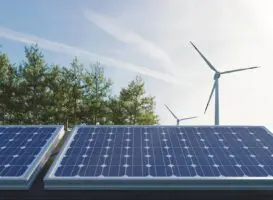South Australia has recorded another record low for demand from grid-scale electricity generators, as solar accounted for some 54 per cent of total customer demand in the state on Sunday.
In a day of records that highlights the rapid changes on Australia’s main grid (see the 1,000MW output from large scale solar), demand in South Australia fell to a new low of 595.4MW, according to Dylan McConnell, from the Climate and Energy College in Melbourne.
McConnell sent through this graph above (and below). The latest record occurred just after noon (NEM time, which is Queensland time as it doesn’t take into account daylight saving), and came at the same time that solar contributed some 54 per cent of local demand.
Most of that solar came from rooftop installations, so even though much of it might have been consumed at home – various appliances, pool pumps, air conditioning and the like – that demand is not visible to the grid.
The Australian Energy Market Operator has been raising concerns about the impact of this for some time now. It predicts that within the next few years, the amount produced by rooftop solar may exceed grid demand in places like South Australia and Western Australia, and is worried about the consequences.
That is underpinning its push to be able to “co-ordinate” distributed energy, looking for more inverters and battery storage technology that can be linked and “orchestrated” as needs arise by the market operator.
 This graph shows how the level of minimum demand has gradually fallen over the years, coinciding by the increase in rooftop solar, which now stands at more than 930MW in South Australia.
This graph shows how the level of minimum demand has gradually fallen over the years, coinciding by the increase in rooftop solar, which now stands at more than 930MW in South Australia.
McConnell says the fall in demand in the middle of the day, which is being accompanied by negative pricing in the middle of the day in various markets, and will be accentuated by yet more day-time solar, could justify new forms of tariffs that could encourage consumers to switch on appliances at that time.
This would be similar to the off-peak tariffs that encouraged consumers and manufacturers to switch their consumption to night-time in the days that coal dominated the grid. One obvious solution is to switch water heating from the night to the day, or at least make it flexible.
The new record low demand was also noted by Paul McArdle, from GlobalRoam and the providers of our popular NEM-Watch widget.
In a piece on his website, WattClarity, McArdle says minimum “scheduled” demand fell to a record low of 536MW at 12.55pm. The difference between his and McConnell’s numbers is explained by fact that McArdle’s figures also subtract non-scheduled wind and some other other non-scheduled generators from grid demand.










